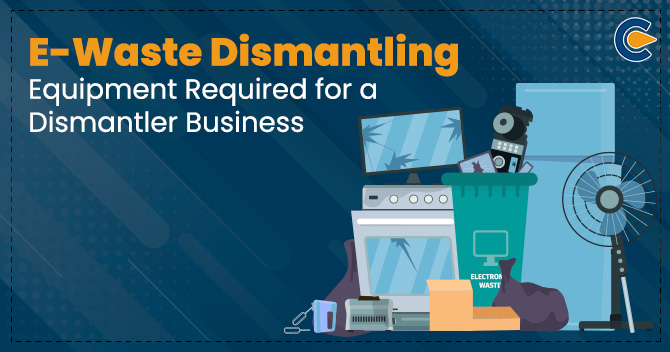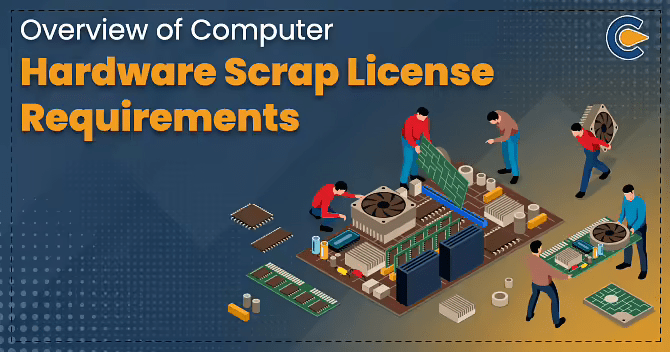E-Waste Management is considered one of the only solutions to curb the increasing problem of E-Waste in India including the process of Recycling, Refurbishing as well as the delegation of responsibilities to various stakeholders. The process of recycling includes the process of collection, Storage, Manual sorting and dismantling, Mechanical separation as well as recovery. E-Waste Dismantling is considered a process of segregating or separating the components in accordance with their utility and whether they can be recycled or not. In this blog you will know about E-Waste Dismantling Equipment.
Process of Dismantling E-Waste
Dismantling is one of the most critical stages of e-Waste management. It involves breaking end-of-use equipment into its constituents, which are then segregated so that the recycling process can be initiated in an easier way. The process of dismantling E-Waste involves: –
- First of all the E-Waste dismantling process includes the process of manual dismantling that separates the WEEE (Waste Electric and Electronic Equipment)
- Next process involves the removal of Hazardous and High-Value Components such as PCB after which the remaining element is mechanically separated.
- Manual dismantling is done to the point where it is not possible to further dismantle the components which are then transported for processing
- At last the pure metals are mechanically shredded.
Basic E-Waste Dismantling Equipment required for the Dismantling process
The dismantling process used by the dismantler differs for different equipment. Some of the common E-Waste Dismantling Equipment to be used in the dismantling process are: –
- Weigh Bridge
- Screwdrivers
- Wrenches
- Pliers
- Wire Cutter
- Tongs
- Hammer
- Special Dismantling Table which has a space de-dusting system in order to keep air quality in the work zone as per the enacted law. The de-Dusting system should contain suction hoods on the dismantling table connected with a cyclone, bag filter, and venting through a chimney three meters height above the roof level.
- Collection Box should also be there near the dismantling table to collect dismantled components.
Authorised Personal Protection Equipments
Along with tools and E-Waste Dismantling Equipments, workers should also be provided with some safety equipment including: –
- Safety Glasses
- Safety Gloves
- Gumboots
- Face Protection
- Shin Guards
- Face masks
These authorised E-Waste Dismantling Equipments are required by the Dismantler to acquire the Authorisation from the competent authority (State Pollution Control Board/Pollution Control Committee)
Space authorised by Central Pollution Control Board for Dismantling Process
As per the guidelines provided by Central Pollution Control Board for the Environmentally Sound E-Waste Dismantling process, the dismantler requires a place for storing WEEE (Waste Electric and Electronic Equipment) till the stipulated time period of One hundred and eighty days. Further, it is projected for dismantling process including storage of raw material and segregated components as well as dismantling operation with a capacity of 1T/day of at least 300 square meters of area.
Responsibilities of Dismantler under E-Waste Management Rules
As per the guidelines provided by Central Pollution Control Board for Environmentally Sound E-Waste Dismantling the dismantler has some responsibilities including:-
- Dismantler must acquire Consent to establish mandated by The Water and Air Act before establishing the Dismantling operation.
- Dismantler must also acquire Consent to operate mandated by The Water and Air Act before initiating the Dismantling operation.
- Along with CTE and CTO the dismantler also obtains authorisation from State Pollution Control Board/Pollution Control Committee under E-Waste (Management)Act
- Dismantlers are not authorised to dismantle fluorescent and other mercury-containing lamps, CRT/LCD/Plasma TV.
- Dismantler is also responsible to ensure that there is no damage caused by the process of storing and transporting E-Waste.
The process of acquiring an Extended Producers’ Responsibility Certificate
E-Waste Management Act, 2016 regulates the procedure for obtaining an E-Waste Dismantler Authorisation from State Pollution Control Board.
- For obtaining E-Waste Dismantler Authorisation application is made to State Pollution Control Board or Pollution Control Committee in accordance with the E-Waste Management Act, 2016.
- After the application is submitted, it is inspected and scrutinised by the SPCB to check its compliance with the guidelines. In case of default with the application or documents submitted, it is sent back to the dismantler for amendment.
- If there are no errors in the Application submitted and all the documents are found to be verified, the authorisation is granted.
Documents to be submitted by producers’ for the dismantling of e-waste
The documents required by the dismantler to be submitted along with Form 1 to the Centre Pollution Control Board are: –
- Documents related to Extended Producers’ Responsibility action plan
- Quantity of E-Waste generated
- Scheme for collection
- Assessed budget for implementing Extended Producers’ Responsibility
- Framework of the scheme in order to generate awareness
- ROHS (Restriction of Hazardous Substances) compliance declaration
- Financial and budgetary plan set aside for Extended Producers’ responsibility
- Self-declaration for compliance with ROHS (Restriction of Hazardous Substances) as per the format given by the Central Pollution Control Board
- Agreement copies made with dealers, Collection Centres, recyclers, treatment, dismantlers, and disposal facilities (TSDFs), storage, etc.
- Copy of license/permissions from the competent department/ministry for the dismantling of E-Waste:-
- TIN (Tax Information Network) Details of the dismantler
- PAN (Permanent Account Number) Details of the dismantler
- CIN (Company incorporation certificate)
- Copy of Import Export Certificate (in case of importers)
- The official documents (supplier declaration- description of the product, document for materials, parts, and sub-assemblies, and analytical test result) as a piece of evidence that the decrease of hazardous substance (RoHS) provisions are accumulated by the product based on standard EN 50581 of EU
- Attested copy of Authorisation granted by state pollution control board/pollution control committee under E-Waste (Management and handling) Rules, 2011 in case dismantlers are working outside the country before 01-10-2016
Obligations of dismantler while dismantling e-waste
The dismantlers in accordance with E-Waste (Management) rules are obligated to adhere to the guidelines provided by Central Pollution Control Board[1] for Proper implementation of E-Waste (Management) Rules concerning acquiring of authorization from the State Pollution Control Board/Pollution Control Committee pursuant to the procedure prescribed under sub-rule (3) of Rule 13. Apart from this dismantler is also liable for keeping a record and filing annual returns to the state pollution control board/pollution control committee.
Conclusion
As per the guidelines provided by the Centre Pollution Control Board on Implementation of E-Waste (Management) Act, 2016 the authorised E-Waste dismantling products are mandatory for getting the authorisation of the dismantling process.
Read our Article:What are the Licenses Needed for dismantling of e-waste











